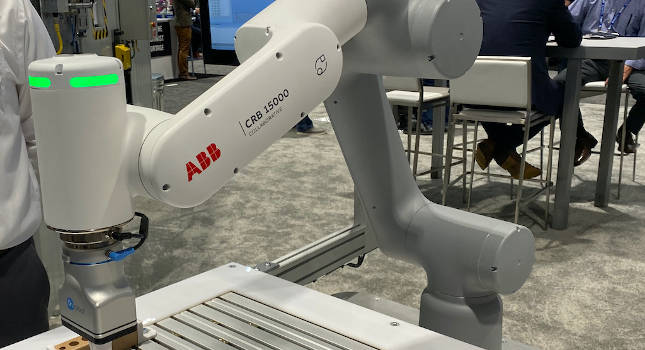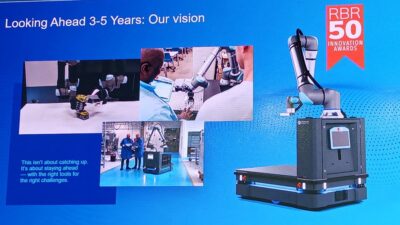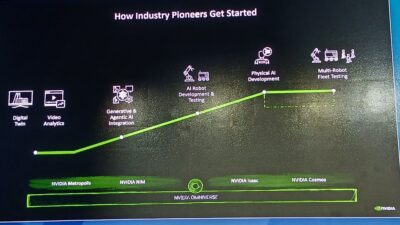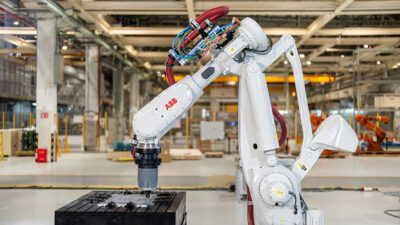Mobile robot options offer many potential benefits for manufacturing and are being used in a growing range of applications.

The need for manufacturing and logistics companies to meet consumer demands for greater choice and faster delivery, against a backdrop of a shrinking labor pool, is leading many to look for new ways of automating their operations.
One answer is the use of mobile robots. Including automated guided vehicles (AGVs) and autonomous mobile robots (AMRs), mobile robots are being adopted in increasing numbers in industrial applications as companies look for ways both to deploy their existing workforces more effectively and maximize the productivity and efficiency of their operations.
Advances in technology are increasing the scope for mobile robots to handle an expanded range of tasks. In the automotive and logistics industries, where uptake has so far been highest, mobile robots are helping to reduce the time and resources needed to convey units between storage and production or distribution stations. While AGVs have remained in widespread use for several decades, the latest generation of AMRs is opening opportunities in new segments and applications by offering enhanced levels of autonomy and intelligence.
Mobile robots have traditionally been used as platforms for carrying large items such as chassis or parts in automotive and parcels and totes in logistics, their use is now extending to other purposes beyond pure transportation. Mobile manipulators that combine AMRs and robot arms represent the next quantum revolution in mobility and have already begun to be deployed in a growing range of applications. The possibilities offered by endowing mobile robots with dexterous manipulation skills similar to those of humans are endless. Indeed, adding manipulator arms on the AMR allows automation to be taken to where it is needed.
Recent developments in vision, navigation and artificial intelligence (AI), coupled with significant reductions in cost, have made autonomous robots increasingly viable for an expanding range of tasks. As the capabilities of the robots has grown, they have become increasingly able to react in real time to their operating environments, avoiding obstacles, including people, and finding the best paths to reduce transit times and improve efficiency.
A key advantage of AMRs is their ability to understand their operating environment, enabling them to navigate around obstacles and operate safely in the presence of human operators. In contrast to AGVs, which require some form of guided paths such as magnetic tape or QR codes to navigate through their environment, AMRs can use data from cameras, laser scanners and other sensors to understand their operating environment and make the decisions needed to move around it.
By using the data to feed simultaneous localization and mapping (SLAM) algorithms, the robot is able to construct a map of its surroundings using the principles of triangulation to detect and locate reference points. These references can be used by the robot to determine its current position and provide the information needed to move around within it.
Flexible automation is a very well-known recipe for success in automated applications. Where mobile robots are concerned, SLAM facilitates this by offering two sets of possibilities. In applications where robots only need to operate within predefined paths, such as relaying parts from the ‘supermarket’ area of an automotive plant to the production line, using SLAM-enabled AMRs provides a flexible alternative to magnetic tape-guided AGVs. SLAM enables alterations to a route to be made simply using a laptop or other device, with the potential to make additional changes if required.
The second possibility offered by SLAM extends to free navigation, where the robot can navigate by itself, for example choosing the fastest route between two points or extending its journey to react to additional information from the fleet management system (FMS). This same autonomous decision-making enables it to react to the presence of obstacles and people, making AMRs increasingly safe to deploy alongside human workers.
Moving to the edge
With ongoing developments in areas such as 2D and 3D vision increasing both the quantity and quality of data supplied to the AMR, there is a growing trend towards deploying edge-based solutions to provide the computational power needed to process the data and relay the required information back at the speeds needed to achieve real-time decision making. Edge computing provides an alternative to purchasing and supporting additional hardware and software, reducing both cost and complexity and providing the flexibility for expanding their AMR fleets and functionality if required.
If mobile robots are the many hands that make light work, then the FMS is the brain that is needed to control them. Acting as the layer between AGVs and/or AMRs and the manufacturing execution system (MES) or warehouse management system (WMS), the FMS provides the environment for monitoring and controlling all aspects of the fleet and mobile robot performance.
Data on the position of every robot can be relayed to the FMS from either control hardware or the edge, enabling real-time control of the fleet.
In addition to acting as an interface for operators to carry out tasks such as modifying routes or checking diagnostics, the FMS also serves a range of other functions, including:
- Managing maintenance status – the maintenance status and condition of every mobile robot can be checked, with any damaged or faulty units being instructed to undertake repairs or checking.
- Optimizing efficiency and robot utilization by ensuring that orders or requests from the MES / WMS are prioritised and relayed to the robot best placed to undertake them.
- Modifying robot paths to undertake additional or replacement tasks, such as where a product may be delayed on a production line or where additional units are needed for fulfillment request.
- Ensuring effective traffic management by rerouting units if required to prevent potential collisions, deadlocks or restricted areas.
- In the event of an alarm condition, ensuring that necessary actions are taken to identify and resolve the root cause and prevent potential safety risks to nearby workers.
While a significant percentage of mobile robots are used in large-scale operations that are already familiar with robotic automation, their use is quickly extending into new sectors as operators become aware of the many advantages they can offer, especially as a means of supplementing depleted workforces. In the industrial sector, potential applications could include use in a wide variety of manufacturing environments that have traditionally relied on either conveyor belts or forklifts to transport goods around the factory floor.
Consider these four tips to help ensure the right solution is chosen:
- Check the ROI – As with any investment in robotic automation, the calculation used to produce the best ROI for mobile robots should consider a variety of key factors including the current costs of human labour that could be used more effectively, the potential for greater throughput, savings through reduced wastage and minimization of errors and the costs of any safety issues that are currently affecting production.
- Consider service and support – Make sure to quiz suppliers about their ability to provide servicing agreements to ensure the solution will be maintained at peak performance, with 24/7 support if anything goes wrong.
- Don’t over-specify – For optimum efficiency, ensure that every mobile robot in the network is fully utilized. While it can be difficult to know exactly how many robots are needed, advanced modeling tools can help calculate the right size of the fleet.
- AGV or AMR? – While AGV is often used to describe both technologies, there is a distinct difference between an AGV and an AMR. Generally speaking, opting for an AGV solution will provide a solution for applications which do not require much flexibility, where the robot will be expected to follow the same paths and where human operators are not likely to be present in the same working area. For applications where the opposite is true, then AMRs can present the better alternative, providing the intelligence and flexibility to handle changing circumstances and with the safety built in to operate alongside people.
– This originally appeared on Control Engineering Europe’s website. Edited by Chris Vavra, web content manager, Control Engineering, CFE Media and Technology, [email protected].



